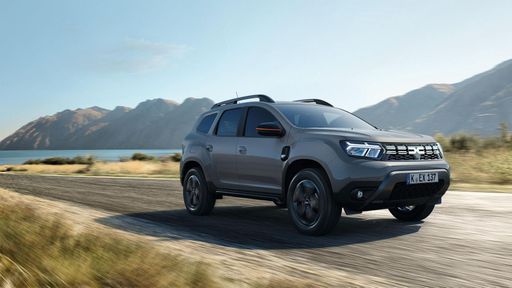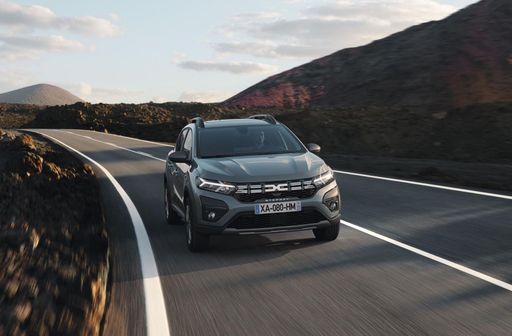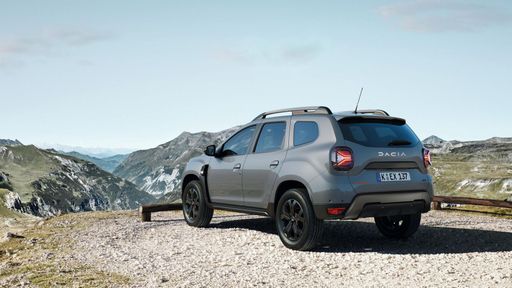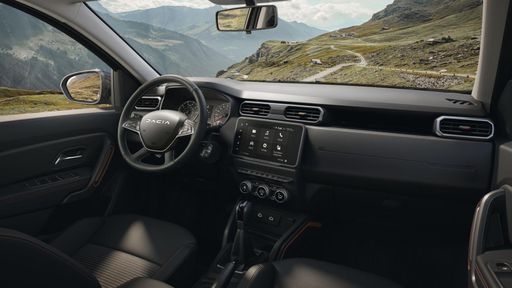Renault Express vs Dacia Duster – Differences & prices compared
Compare performance, boot space, consumption and price in one view.
Find out now: which car is the better choice for you – Renault Express or Dacia Duster?
The Renault Express (Cargo Van) comes with a Diesel or Petrol engine and Manuel transmission. In comparison, the Dacia Duster (SUV) features a LPG, Full Hybrid or Petrol MHEV engine with Manuel or Automatic transmission.
When it comes to boot capacity, the Renault Express offers , while the Dacia Duster provides 517 L – depending on how much space you need. If you’re looking for more power, decide whether the 102 HP of the Renault Express or the 140 HP of the Dacia Duster suits your needs better.
In terms of consumption, the values are 4.60 L per 100 km for the Renault Express, and 5 L for the Dacia Duster.
Price-wise, the Renault Express starts at 17100 £, while the Dacia Duster is available from 16300 £. Compare all the details and find out which model fits your lifestyle best!
Renault Express
The Renault Express brings a fresh design to the van segment, combining practicality with modern styling cues. Its spacious interior and clever storage solutions make it an ideal choice for both business and leisure purposes. With a focus on comfort and functionality, this vehicle stands out as a versatile option for those in need of reliable transportation.
detailsDacia Duster
The Dacia Duster represents a compelling choice for those seeking an affordable yet robust SUV in the market. With its rugged design and practicality, it tackles both urban commutes and off-road adventures with ease. Inside, the vehicle offers a spacious cabin that ensures comfort, while maintaining its reputation for delivering excellent value for money.
details @ dacia-presse.de
@ dacia-presse.de
 @ dacia-presse.de
@ dacia-presse.de
 @ dacia-presse.de
@ dacia-presse.de
 @ dacia-presse.de
@ dacia-presse.de

|
|
|
|
|
Costs and Consumption |
|
|---|---|
|
Price
17100 - 19500 £
|
Price
16300 - 24800 £
|
|
Consumption L/100km
4.6 - 6.6 L
|
Consumption L/100km
5 - 8.1 L
|
|
Consumption kWh/100km
-
|
Consumption kWh/100km
-
|
|
Electric Range
-
|
Electric Range
-
|
|
Battery Capacity
-
|
Battery Capacity
0.60 kWh
|
|
co2
121 - 149 g/km
|
co2
114 - 147 g/km
|
|
Fuel tank capacity
50 L
|
Fuel tank capacity
49 - 55 L
|
Dimensions and Body |
|
|---|---|
|
Body Type
Cargo Van
|
Body Type
SUV
|
|
Seats
2
|
Seats
5
|
|
Doors
4
|
Doors
5
|
|
Curb weight
1296 - 1390 kg
|
Curb weight
1351 - 1465 kg
|
|
Trunk capacity
-
|
Trunk capacity
430 - 517 L
|
|
Length
4393 mm
|
Length
4343 mm
|
|
Width
1775 mm
|
Width
1813 mm
|
|
Height
1811 mm
|
Height
1656 - 1661 mm
|
|
Payload
575 - 700 kg
|
Payload
414 - 430 kg
|
Engine and Performance |
|
|---|---|
|
Engine Type
Diesel, Petrol
|
Engine Type
LPG, Full Hybrid, Petrol MHEV
|
|
Transmission
Manuel
|
Transmission
Manuel, Automatic
|
|
Transmission Detail
Manual Gearbox
|
Transmission Detail
Manual Gearbox, Automated Manual
|
|
Drive Type
Front-Wheel Drive
|
Drive Type
Front-Wheel Drive, All-Wheel Drive
|
|
Power HP
75 - 102 HP
|
Power HP
91 - 140 HP
|
|
Acceleration 0-100km/h
11.9 - 16.3 s
|
Acceleration 0-100km/h
9.9 - 14 s
|
|
Max Speed
100 - 167 km/h
|
Max Speed
160 - 180 km/h
|
|
Torque
200 - 240 Nm
|
Torque
160 - 230 Nm
|
|
Number of Cylinders
4
|
Number of Cylinders
3 - 4
|
|
Power kW
55 - 75 kW
|
Power kW
67 - 104 kW
|
|
Engine capacity
1332 - 1461 cm3
|
Engine capacity
999 - 1598 cm3
|
General |
|
|---|---|
|
Model Year
2021
|
Model Year
2024 - 2025
|
|
CO2 Efficiency Class
D, E
|
CO2 Efficiency Class
D, C, E
|
|
Brand
Renault
|
Brand
Dacia
|
Renault Express
Introduction to the Renault Express
The Renault Express, a compact van from the renowned French manufacturer, continues to make a lasting impression in the versatile light commercial vehicle segment. With its practical design and array of engine configurations, it caters to a wide spectrum of business needs, offering both diesel and petrol variants. As we delve into the details, we'll explore the specifications and innovations that set the Renault Express apart from its competitors.
Efficient Powertrains
The Renault Express boasts a diverse range of engines tailored for efficiency and performance. At the core, it features a selection of both diesel and petrol engines, with outputs ranging from 75 PS to 102 PS. This ensures that operators can select a powertrain that precisely matches their performance requirements and budget constraints.
Whether you opt for the BLUE dCi diesel engine or the TCe petrol variant, the Renault Express promises robust performance combined with impressive fuel economy ranging from 4.6 to 6.6 L/100km. The manual transmission and front-wheel drive configuration further contribute to its efficient operation.
Practicality and Usability
Designed with practicality in mind, the Renault Express excels in usability. With a load capacity ranging from 575 to 700 kg, it provides adequate cargo space for business users. Its compact dimensions—measuring 4,393 mm in length, 1,775 mm in width, and 1,811 mm in height—ensure it remains manoeuvrable even in tight urban environments.
The van’s 50 L fuel tank complements its fuel-efficient nature, minimizing the frequency of refuelling stops and enhancing productivity.
Comfortable and Functional Interior
Inside the Renault Express, a no-nonsense cabin offers comfort and functionality across its two-seat configuration. The straightforward yet ergonomic layout is designed for those who spend significant time on the road. Essential features are included to support the driver, ensuring a pleasant experience even during long journeys.
Safety and Innovation
Renault has not compromised on safety with the Express. With modern safety protocols, the van aims to offer peace of mind to its occupants. Although it's built primarily for utility, the inclusion of essential safety features demonstrates Renault’s commitment to protecting its drivers and cargo.
Innovation is further represented through its environmental considerations, such as the CO2 efficiency class spanning D to E, and emissions ranging from 121 to 149 g/km. This conscientious engineering underscores Renault’s efforts towards a more sustainable future.
Final Thoughts
In conclusion, the Renault Express is a testament to Renault's expertise in crafting efficient, reliable light commercial vehicles. Its blend of power, economy, and practicality makes it a competitive choice for businesses seeking a dependable partner on the road. With a starting price point that remains accessible, the Renault Express continues to deliver exceptional value to its customers, making it a standout in the small van category.
Dacia Duster
Discovering the Duster: Dacia's Affordable SUV
The Dacia Duster has long been a go-to choice for those seeking an affordable yet competent SUV. Known for its robust design and versatility, the new 2024 model year offers even more options to fit a variety of needs. Let's delve into the technical details and innovative aspects that set the Duster apart.
Engine Diversity: Tailoring to Your Needs
The Dacia Duster doesn't disappoint when it comes to engine variety. With options ranging from Gas and Voll-Hybrid to Benzin Mild-Hybrid, there's something for everyone. The engine power spans from 91 to 140 PS, providing levels of performance suited to different driving styles. Notably, the hybrid options are a nod to the growing demand for more eco-friendly vehicles while still maintaining affordability.
Efficiency and Performance in Harmony
Efficiency is a key highlight of the Duster lineup. Fuel consumption rates from 5 to 8.1 litres per 100 km make it a great choice for budget-conscious drivers. Coupled with acceleration times ranging from 9.9 to 14 seconds for 0-100 km/h, the Duster provides a balanced blend of economy and performance.
Precision in Design: Dimensions and Interior Space
The Dacia Duster stands at 4,343 mm in length, 1,813 mm in width, and height varies between 1,656 to 1,661 mm. These dimensions create an ample interior, comfortably seating five passengers with a boot capacity ranging from 430 to 517 litres. This is further enhanced with the different trim levels such as Essential, Expression, Extreme, and Journey, each offering various features.
Advanced Drivetrain Options
Dacia has always been keen on providing choice in drivetrain configurations to cater to a wider audience. The Duster is available with both front-wheel and all-wheel drive options, powered by either a manual or automatic transmission. This flexibility ensures that the Duster can handle both urban commutes and off-road adventures with equal competence.
Technical Specifications: A Deep Dive
The Dacia Duster is equipped with a variety of technical features that ensure a smooth driving experience. It features a range of torque outputs from 160 to 230 Nm, depending on the model. The vehicle's weight varies between 1,351 and 1,465 kg, which aids in its adept handling and stability. Moreover, the Duster meets modern safety expectations with CO2 emissions ranging from 114 to 147 g/km. The SUV's CO2-Effizienzklasse spans from D to E, reflecting its environmental considerations.
Conclusion: A Solid Choice in the SUV Market
The Dacia Duster remains a solid choice for drivers seeking an SUV that combines affordability, efficiency, and versatility. With its wide range of configurations and technical prowess, it continues to be a competitive player in the SUV segment. Whether you're after fuel efficiency, a bit more power, or the capability of off-road adventures, the Duster has you covered.
The prices and data displayed are estimates based on German list prices and may vary by country. This information is not legally binding.
